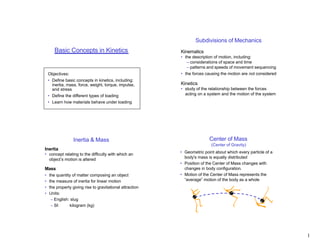
Lecture 12
- 1. Subdivisions of Mechanics Basic Concepts in Kinetics Kinematics • the description of motion, including: – considerations of space and time – patterns and speeds of movement sequencing Objectives: • the forces causing the motion are not considered • Define basic concepts in kinetics, including: inertia, mass, force, weight, torque, impulse, Kinetics and stress • study of the relationship between the forces • Define the different types of loading acting on a system and the motion of the system • Learn how materials behave under loading Inertia & Mass Center of Mass (Center of Gravity) Inertia • Geometric point about which every particle of a • concept relating to the difficulty with which an body's mass is equally distributed object’s motion is altered • Position of the Center of Mass changes with Mass changes in body configuration. • the quantity of matter composing an object • Motion of the Center of Mass represents the • the measure of inertia for linear motion “average” motion of the body as a whole • the property giving rise to gravitational attraction • Units: – English: slug – SI: kilogram (kg) 1
- 2. Force Actions of Forces • A mechanical interaction between an object and • Forces cause acceleration or deformation (a its surroundings change in shape) – We will assume that the forces acting on a body • The “push” or “pull” of one object on another cause minimal deformation • Force is a vector. It has: • Relationship between force (F), mass (m) and – a magnitude acceleration (a): – a direction – a point of application F F=ma point of • Units: application θ – English: pound (lb.) = (1 slug)(1 ft/s2) – SI: Newton (N) = (1 kg)(1 m/s2) – 1 lb. = 4.45 N Net Force Concentrated vs. Distributed Force • Resultant force derived from the composition of Concentrated Force two or more forces • A force that is applied at a single point • Reflects the net effect of all of the forces acting Distributed Force together • A force that is applied over a distributed area F4 • Can be approximated by a concentrated force F1 that has the same net effect Fnet F5 F5 F1 F4 F3 F2 F3 Fground F2 Fground 2
- 3. Weight Density & Specific Weight • The force due to gravity (i.e. the pull of the Earth) • Volume : The amount of space occupied by a body. • Weight has magnitude: Measured in (unit of length)3 (e.g. m3, ft3) • Density (ρ): mass per unit volume: W=mg ρ = (mass)/(volume) where: m = mass SI Units: kg/m 3 g = acceleration due to • Specific Weight : weight per unit volume gravity (9.81 m/s2; 32.2 ft/s2) (specific weight) = (weight)/(volume) • Weight always acts at the W center of mass and points English Units: lb./ft3 towards the center of the Earth SI Units: N/m3 Torque Impulse • A measure of the extent to which a force will cause • The motion of a body depends not only on the force, an object to rotate about a specific axis but also on the duration that the force is applied • A net force applied through the center of mass produces translation • Impulse : a measure related to the net effect of • A net force applied away from the center of mass applying of force (F) for a time (t): (i.e. an eccentric force) produces both translation and rotation Impulse = F t • Impulse increases with: – Increased force magnitude – Increased duration of application F F • Equal impulses result in equal changes in velocity 3
- 4. Compression, Tension, & Shear Stress & Pressure • Compression : pressing or squeezing force • Stress: The force distributed over a given area: directed normal (perpendicular) to a surface F • Tension : pulling or stretching force directed σ= F A normal to a surface • Shear : sliding or tearing force directed parallel where: to a surface σ = stress A F = total force applied Fn A = area force is applied over Fn Fs • Units: – English: pounds per square inch (psi) = 1 lb./in 2 – SI: Pascal (Pa) = 1 N/m2 Compression Tension Shear • Pressure: stress due to a compressive force Bending Torsion • Asymmetric loading that produces tension on • Load producing a twisting of a body one side of a body, compression on the other • Creates shear stresses • Compressive and tensile stresses are greatest • Shear stresses are greatest at the surface at the surface F2 Compression Tension F3 Cross-section F1 Cross-section 4
- 5. Deformation Repetitive vs. Acute Loading • Materials behave elastically at small loads • The size of the loading required to cause a material • Loads above the yield point create permanent plastic to fail (i.e. fracture or rupture) decreases as the deformation number of loading cycles increases • Rupture or fracture occurs at the ultimate failure point Stress Causing Failure Yield Point Ultimate Elastic Stress Failure Region Point Injury Likely To Occur Plastic Region Deformation # of Loading Cycles 5
